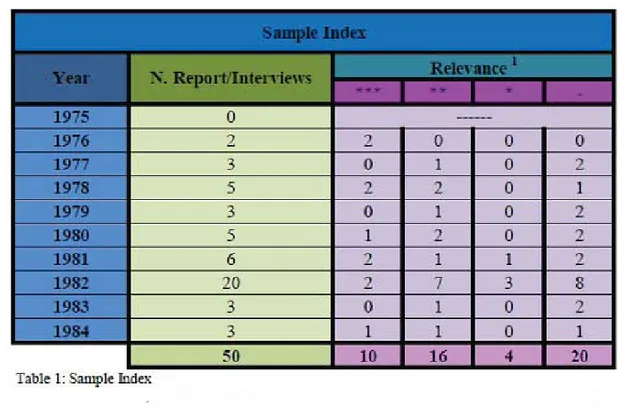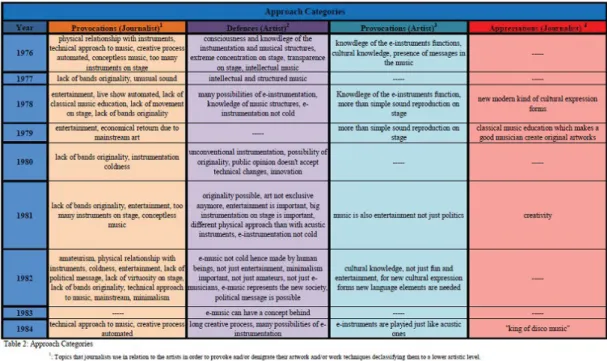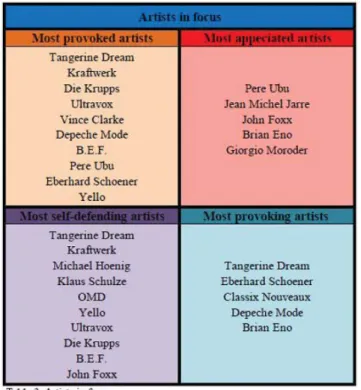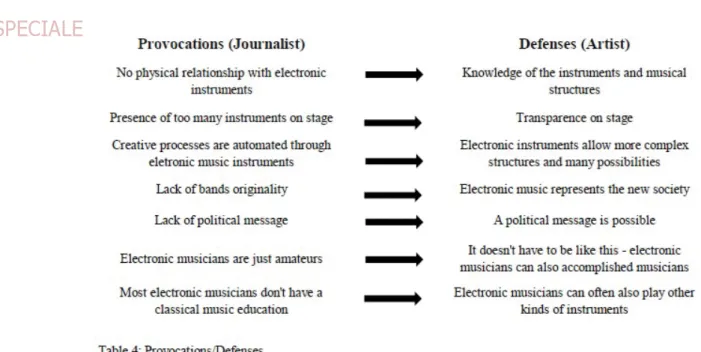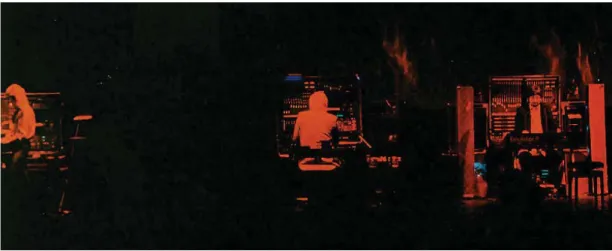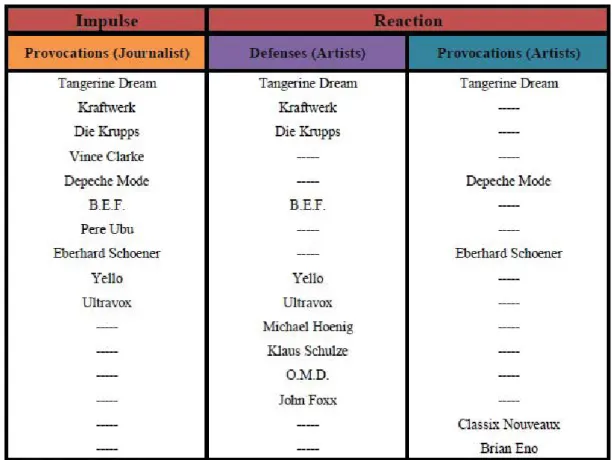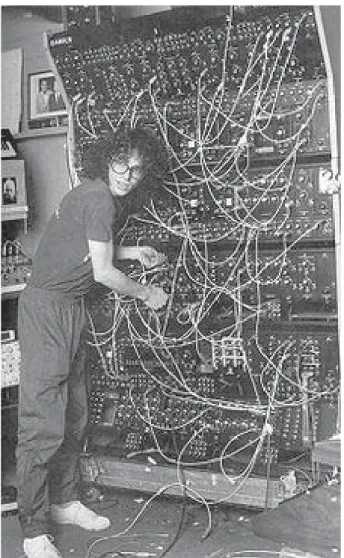SPECIALE
9
CINERGIE
il cinema e le altre arti
Blaming or Defending Disco?
Analyzing the historical development of the mainstream
journalistic discourse about authenticity of electronic music
in Germany during the decade 1975-1984
The Work of Music in the Age of Electronic Reproduction
With the description “a unique phenomenon of a distance, however near it may be”1 Walter Benjamin
defi ned the concept of aura. In his essay The Work of Art in the Age of Mechanical Reproduction (1936), he observed a loss of the exclusive nature –the authenticity - of the artworks, which at that point started to be technically reproducible through the rise of new media technologies such as photography, phonography and fi lm. In his view, these developments would ultimately turn art’s function into a mere entertainment product. The new technologies would encourage the masses to take part in the artistic production, since these enable performers to test their acts in front of an equipment, and consequently wouldn’t need an elevated degree of virtuosity.2
Similar socio-cultural consequences of technology-related transformations of artistic production and distribution techniques were also described by Theodor W. Adorno in his essay Kulturindustrie (1944)3
under the notion of Amusement. With this concept he pictures a society where the cultural industry spreads its insubstantial products and subverts the revolutionary function of art by means of new media reproduction techniques, which would allow the serial reproduction of formerly singular artworks and cultural contents.4 That allegedly leads to a popularization of cultural engagement (meant pejoratively),
as well as to a growing degree of dilettantism on the artists’ side, which would result in a loss of subversive potential through a style’s unifi cation brought by the new techniques’ essence.
Adorno’s abstract theory fi nds a specifi c application in other studies5, where he counterpoises serious
and popular music, which e believes correspond to the dichotomy of high/low culture. Here the concept of Amusement has been applied to the supposedly passive and automatic reception of popular music, in which he remarks the presence of pre-given and easily recognizable frameworks, that, in contrast to the structure of serious music, would not be constituted by a solid system of meticulously concatenated details. Music would therefore turn into an inconsistent medium for entertainment, whose principal aim is to relax the listeners worried by society’s pressure, leading them to act like purchasers of consumable goods in order to satisfy their needs. Furthermore, as the author suggests6, the “technologization”
process of music lets the latter submit to the dominion’s will of conformity with means of its omnipresent and standardized character, leading to an alleged loss of aura of the recorded artworks. The result, the mass-distribution of recorded music, appears to be the antithesis of what Adorno considers as the only authentic musical dimension one can still recognize in the artistic interpretation, the live performance. This general discourse about popular music can be applied to the specifi c case of electronic music, as well as Walter Benjamin’s arguments, since electronic-musicians and producers have also been affected by similar critiques in the past, mostly brought forth from the side of the Pop/Rock specialists. This predominantly concerns the alleged lack of authenticity and virtuosity due to their use of electronically-programmable-instruments, which principally allows them to program, register and test their musical actions on a medium before their “live performances”, and therefore enable the possibility to always playback the same performance. Since their emergence, new electronic-music styles relying on computer technologies have been confronted and compared to the traditional way of performing music through acoustic (and electrically-amplifi ed) instruments, where musicians have an aleatory approach to the performance, which therefore preserves its unique nature because of its intrinsic material impossibility of repeating exactly the same set more than once. For these reasons electronic-instrumentation has
SPECIALE
9
CINERGIE
il cinema e le altre arti
been inculpated by Rock authors of emptying the performance from its central “authentic” values like exclusivity and unrepeatability, transforming it into a form of mere entertainment. Indeed, starting from the ‘60s, white Rock music (and later Psychedelic Rock) acquired its “hegemonic” status thanks to its rebellic and easily-sellable character, which smoothly led to a wide-accepted “auratic” attribution regarding the guitar-dominated style. During the following decade, electronic music further highlighted this quality acquired by Rock music, hence the alleged lack of aura and authenticity of the former, that has been strongly remarked as contrast to it.
Furthermore, new music technologies tend to allow more people to express themselves by music, since the equipment costs are lower and they give the possibility to produce good quality tracks without a proper studio. These developments have often been interpreted as a spreading wave of dilettantism in the musical environment by mainstream press and Pop/Rock avant-garde.
Nowadays, electronically-programmable and software-based instruments have been completely integrated into our culture, allowing musicians’ creative processes to be developed within new parameters, through automating basic musical craftsmanship and allowing artists to concentrate on other production layers. The opportunities offered by the new instrumentation (e.g. huge variety of timbres, tones and semitones)7 brought a deep change into long-established musical paradigms within the Western society.
This was already predicted and desired by avant-garde composers in the early decades of the Twentieth Century, as e.g. Edgar Varèse (1936):
“[…] The new instruments will allow me to write music as I conceive it, […] There will no longer be the old conception of melody or interplay of melodies. The entire work will be a melodic totality. The entire work will fl ow as a river fl ows.”
Edgar Varèse, “The Liberation of Sound”, in Christoph Cox, Daniel Warner, Audio Culture, Bloomsbury Academic, New-York, 2004, pp. 17-21, pp. 17-18.
SPECIALE
9
CINERGIE
il cinema e le altre arti
Music fl ow is one of the most characterizing elements in contemporary electronic and dance culture, which has its roots in the early 1900s when experiments were made in this fi eld by personalities like the Russian Lev Termen, who invented the only one instrument playable without body contact: the Theremin.9
Over the next decades, huge developments were made concerning new modes of musical expression by employing electronics, e.g. investigations on tapes’ sound modifi cations in Pierre Schaeffer’s musique
concrète in the ‘40s8, as well as the fi rst computer technologies in the ‘50s, that represent the foundations
for electronic-programmable-instruments introduced in the early ‘70s.
Shortly before the early ‘70s, the latter started to be serially produced by large manufactures like Moog, and, some years later, they became affordable for the most mass-consumers. Consequently, this kind of instrumentation started to be integrated into band projects mostly related to the Pop/Rock music productions, especially in Germany, where, since the early ‘50s, different pioneers like Robert Eimer and Karlheinz Stockhausen experimented on electronically-generated sound.10 In fact, during the early
‘70s, the German musical landscape offered a great variety of popular music artists, which incorporated infl uences of Psychedelic Rock to the new musical tendencies in their works, giving birth to a unique music style (ironically) named “Krautrock” which was widely appreciated abroad but hardly recognized by the German audience. Exponents of these styles were bands like Ash Ra Tempel and Tangerine Dream, who both collaborated with the prominent musician Klaus Schulze, or Kraftwerk. The latter have been active since 1968 using exclusively electronically-programmable-instruments and in 1974 produced the fi rst album belonging to the Synth-Pop genre, “Autobahn”, that affi rmed the potentialities of this new wave of German musicians worldwide.
Nevertheless, at that time, electronic infl uences on music production were heavily stigmatized from the Pop/Rock avant-garde, who, as argued by US author Richard Dyer in its article “In Defense of Disco” (1979), related it to a vacuous cultural-transmitter of “wrong values”, such as capitalistic music production, superfi cial and escapist utopia, lack of oppositional and political message, excessive emotionality and unauthentic musical aesthetics.12 In his essay, Dyer conversely praises the new music genres like Disco
(which can be regarded as an electronically-infl uenced forerunner of the electronic-dance-music genres appearing at the same time in Germany), reconsidering them under another point of view, as being a kind of new musical approach, which would encourage personal contacts and offering a way out from everyday capitalistic life. Hence, he interprets them as, expressing a subversive potential under a new form.13
The aim of this paper is to investigate the point in time when a parallel cultural debate about the alleged problem of authenticity and virtuosity of electronically produced and performed music began to proliferate within the discourse about popular music in Germany, and what evidence has been brought forth to sustain mainstream and Rock avant-gardistic arguments, as well as what kind of discursive strategies were used toward artists embracing new technologies in their composition’s concept.
Power and Discourse
In order to analyze the point in time when the discourse in focus started to become a fundamental topic for the mainstream press dedicated to a music-interested audience, and in order to understand the nature of accusations that have been leveled against artists using electronically-programmable-instruments, the used sample has been considered following Michel Foucault’s theory in The Order
of Discourse12. In his essay, published in 1971, Foucault introduces the idea that discourses cannot
proliferate freely within society, but they are limited and controlled by societal institutions, which create specifi c mechanisms and procedures directing them into certain patterns in order to govern their power and subversive force.14
SPECIALE
9
CINERGIE
il cinema e le altre arti
Foucault’s theory has been applied by numerous other scholars interested in the relationship between discourse and power which led to the development of several different methods to analyze disparate aspects of this abstract concept. Fairclough’s15 and Gee’s16 guidelines have been chosen in the current
case because of their concerns for the social structures that are affected by conventions of social institutions. Their technique of interpreting linguistic elements within a given framework by going beyond merely linguistic issues towards the ideology domain through social settings and intertextual contexts aims to deduce hidden rules and (de)legitimizing strategies of implicit mass-media discourse.
These instructions have been used on a sample of 50 articles17 on musical artists active in Germany
in the decade 1975-1985, who were working with electronically-programmable-instruments, in order to observe and critically discuss how discursive elements are imposed by the society by means of mass-media as mainstream divulgation tools.
The chosen articles were published in the mainstream generalist music magazine Musikexpress (fi rst issued in 1969), edited by the German publishing house Axel-Springer-Verlag (founded in Hamburg in 1946), one of the largest publishing houses in Germany and in Europe, well-known for its corporate principles oriented at western capitalist liberal market economy. Musikexpress was at that time the only publication of Axel-Springer-Verlag focusing on a topic related to cultural and musical industry, alongside the most known Rolling Stone – magazine for Rock and Pop culture founded in 1967 -. In fact, the production-line of this enterprise, publisher of one of the best-sold newspapers in Germany (the daily Die Welt), principally concerned with the news divulgation in a tabloid format, a journalistic style which tends to present the concerned topics under an entertaining perspective, as in the renowned
Bild-Zeitung and B.Z.
Since the late ‘60s, the Axel-Springer-Verlag has been recurrently attacked concerning its political and business choices in the cultural fi eld. As e.g. put by Kurt Becker (1968), “[...][The Axel-Springer-Verlag] positions itself in the market under a pseudo-entrepreneurial perspective and submits completely to the laws of the market-taste and the elusive entertainment-necessities [...]”.17 Under this point of view,
media outlets published by the Axel-Springer-Verlag within the cultural fi eld may be considered as acts of the ruling economic classes exercising hegemonic power in terms of masses’ mentality and ideology. Therefore, I will consider the outlets of the Springer magazine Musikexpress as the “voice of the institution” throughout the present analysis.
The choice of analyzing a magazine like Musikexpress was taken in order to analyse how mainstream culture publication organs approached the music-cultural change in focus, at times when it may have been already successfully accepted by more specialist avant-garde Pop/Rock German publications as
Sounds or Spex.
The decade 1975-1984 was selected because of the synthesizers’ and drum machines’ dramatic spread in the music market between the end of the ‘70s and the middle of the ‘80s. At this point in time, more advanced and cheaper technologies (e.g. Asian digital synthesizers, MIDI technology) were available, and a considerable amount of bands and musicians were no longer operating in the fi eld of electronic-music under a pioneering perspective, but instead as a systematic choice. Specifi cally, interviews and reports about debutants have been adopted for this analysis with the aim of considering artists’ direct reactions to provocations or appreciations of the journalists related to musician’s authenticity and electronic-music’s critical content.
SPECIALE
9
CINERGIE
il cinema e le altre arti
Cultural Industry’s Loud Voice
Table 1 shows the number of articles (interviews and reports) published, during each year of the considered decade 1975-1984, as well as the degree they are related to the research question (an example of the considered artists can be found in Table 3). Some of the items appeared to be not relevant to the research’s purposes, since they focused on other musicians’ and bands’ aspects (e.g. gender, theatrical temperament, particular voice timbre).
The most striking result regarding this index is the complete absence of reports or interviews related to the investigated topic during the year 1975, which shows the editorial choice not to consider musicians active with electronically-programmable-instruments under any point of view at that time, although synthesizers and drum machines were already in use.
During year 1976, except for the last two months (November and December), the editors of Musikexpress still didn’t release any reports or interviews under the project’s selection criteria, although it seems that the magazine somehow “prepared” its audience to the new tendencies by writing a four-episode dossier from June until September called Musik aus der Steckdose19. Within this special, the journalists depicted
a profi le of the emerging mass-phenomenon of electronic and dance music, dedicating each episode to another root of these new musical styles, as well as to the terminology necessary to talk about and understand their operating principles by means of a glossary. Starting from the end of that year, the monthly periodical began to partly direct its editorial interests to the emerging genres, even though until 1982 the number of reports and interviews in the researched context seem to be limited to a certain modest amount. Interesting to note in Table 1’s index is a dramatic increase of interest for the considered topic during the year 1982, where not only two columns primarily dedicated to new electronic-music artists were introduced but also the most signifi cant number of issues in the thematic context were
SPECIALE
9
CINERGIE
il cinema e le altre arti
published: Deutsche Tänze and Neue Gesichter20. The two columns ceased to exist already during the
year 1983, where just a few articles and interviews under the selection criteria have been published until the end of the considered decade.
Table 2 shows the categories developed to describe the editorial approach towards musicians that extended their composition methods to the electronically-programmable-instruments and the evolution of the topics’ nature during the investigated decade, as well as the artists’ reactions when consulted or provoked in interviews concerning their use of non-acoustic instruments. The most recurring topic that the journalists used in relation to the artists in order to provoke and/or denigrate their work techniques and thereby declassify them to a lower artistic level is the lack of originality. Alongside, it is often stated that that their sound seems similar to that of other artists (and is therefore not authentic). Moreover, the accusation of producing mere entertaining music which doesn’t carry any political or ideological message is expressed.
As shown in this index, there is a signifi cant amount of provocations by the journalists towards the concerned artists, as well as defenses of the latter, who try to respond to the attacks giving their own arguments to the accusations. These two kinds of discursive practices create a circle pattern around the topic in question. Another interesting (re)action modality musicians use to face the issue without taking part in the provocation-game, is challenging the institutional idea that electronic and dance music as popular genre would not be authentic or subversive due to their intrinsic nature.
In some exceptional cases journalists express real appreciation toward the artists, esteeming their artwork aside from the essence of the played instruments. These seldom cases will be discussed in the next section together with a synopsis on the timely development of the topic’s nature in terms of provocations and defenses by both artists and journalists.
SPECIALE
9
CINERGIE
il cinema e le altre arti
Table 3 shows which artists have been most provoked or appreciated, and which of them reacted defending themselves or provoking the journalist’s position. One can observe that the majority of interactions were following the classical pattern provocation/defense, whereas just a minority of artists was able to provoke the journalists who in turn also very seldom expressed appreciations to the concerned musicians.
Do Synthesizers and Drum Machines make Musicians?
As the analysis’ results indicate, Musikexpress’ editors choose to omit the topic around the growing phenomenon of electronic and dance music genres until year 1976, neglecting its importance in the international musical landscape. After that, the periodical started to release fi rst interviews and articles with electronic musicians, which in most cases were subjected to provocations on different levels. Nevertheless one can observe a certain kind of evolution of the provocation’s subjects within the considered decade: whereby during the fi rst years (until around 1978) journalists focused mostly on the technical issues of electronic-music production (such as the physical relationship with the instruments, both in studio and on stage), around the beginning of the 80’s the accusations tended to shift more towards the creative domain of composition. This process escalated until 1982, where the highest number of debut bands were consulted and questioned about their use of drum machines and synthesizers. It decreased during the last two years (1983-1984) and gave space to another kind of debate about the new generation’s computer-based instruments, such as software and sequencers.
The topics’ domains in which the artists move their defenses, in order to argue for their artwork’s authenticity against the journalists’ accusations, result parallel with to latter, as being a reaction to those.
SPECIALE
9
CINERGIE
il cinema e le altre arti
Table 4 shows the most recurring provocation/defense patterns that arose in relation to the discourse about electronic and dance music’s authenticity and ideological message. Within the articles, the weight of the journalists’ accusative topics and the artists’ responses do not seem to be equivalent: in fact, the musician’s arguments are ordered into the text in a way in which they appear weak and not convincing, as if they would exhibit feelings of guilt in relation to these issues.
MUSIKEXPRESS: “Hoenig introduces himself as a non-musician:”
MICHAEL HOENIG: “Since the beginning of my career I have always just pressed [synthesizer]
keys. Chords, triads and harmonics don’t have a signifi cant meaning for me.”
MUSIKEXPRESS: “How can this be possible?”
MICHAEL HOENIG: “Well, I have been doing this kind of introduction now for several years. [..]
I don’t have any classical music education... Nevertheless I am able to build up harmonies and sound structures...”
Michael Hoenig, “Blubber, blubber, zisch…Der Elektronik Michael hebt ab!“, Musikexpress, n. 8 (August 1978), pp. 9-10.[Translated by the author]
As the example above shows, the style of depicting the interview legitimizes a natural correspondence between being a “real musician” and having had a classical music education. In this way, it excludes the possibility of becoming a musician by taking another kind of socialization. On his side, the referred artist doesn’t seem to defend his own artistic style by claiming it to be something unique, but rather takes up the questions topic through answering that he nevertheless possesses basic skills that allow him to function like a “real musician” (e.g. knowledge of musical harmonies and structures). Thereby his answer also legitimizes the institutional idea that a musical artist needs a classical music education.
Another mode of reaction that musicians use to protect themselves from the attacks is to accuse other artists by using the same institutional arguments:
SPECIALE
9
CINERGIE
il cinema e le altre arti
MUSIKEXPRESS: “[…] And again, like D.A.F21, you use textual imperatives.”
DIE KRUPPS: “They [D.A.F.] also want to create something new, a kind of differentiated rhythm
work, [...] when I was performing together with D.A.F., I simply controlled the tape-recorder on stage.”
Die Krupps, (no title), Musikexpress, n. 3 (March 1982), pp.26-27. [Translated by the author] In this case a member of a new band implicitly criticizes his old band for using a tape-recorder on stage, implying a loss of quality of the artistic creation because of its automation, in order to protect themselves from the accusation of not being authentic. This example demonstrates a certain kind of insecurity on the electronic music artists’ side, which appears diffi cult to be dealt with in their essence.
Nevertheless there is another kind of reaction that at least some artists exhibited towards the provocations: the one of remaining outside the debate and being themselves provokers, not accepting the standardized accusations directed towards electronically-programmable-instruments and preserving them from being considered of being non-authentic or pure entertainers.
MUSIKEXPRESS: “What kind of physical relationship do you have with your [electronic]
instruments? Is it the same as with guitars?”
TANGERINE DREAM: “It is just an optical difference, [while playing electronic instruments you
are] extremely concentrated, you are fully committed and this is also a physical experience, even if no one down there is able to perceive it. [...] And while you turn the knobs and press the keys you are able to hear the sound you produce instantly! You don’t have to wait 5 minutes in order to be able to hear something!”
Tangerine Dream, “Ein Traum bekommt Flügel“, Musikexpress, n. 11 (November 1976), pp.8-10. [Translated by the author]
In the example above the band fi rst explains the feelings they have in relation to their electronic instruments, comparing them, as they were asked for, to the relationship towards acoustic instruments. After referencing the discourse on alleged virtuosity problems itself (“[...]even if no one down there is able
SPECIALE
9
CINERGIE
il cinema e le altre arti
to perceive it.”), they make jokes on the journalist’s “ignorance” concerning electronic instrumentation. In this case they appear as the ones who “know” what they do and exhibit an authentic and high degree of concentration needed for electronic compositions. Effectively, the journalists’ provocation-game doesn’t reach its goal of demotivating the readers’ interest regarding electronic music. Nonetheless, the amount of musicians who were so self-assured to face this topic with such a degree of sovereignty are very few, compared to the ones who just to avoid the accusations.
Table 5 above shows the artists’ (re)actions to the provocative editorial impulses. As mentioned previously, just a small number of musicians which have been provoked because of their electronically-programmable-instrumentation react to the affronts by accusing the journalists themselves of not being prepared to an epochal change of music techniques. Most of those who did, were actually well-known bands of musicians, mostly with a classical music education. Furthermore, one can note the presence of the band Depeche Mode23 within this group, who have been heavily accused under many point of views
and about many different topics within the researched issue. During the second part of an interview with this band, one of the members appears to be so bored about the low consideration dedicated to the band that he just starts to joke ironically about the journalists arguments, thereby overturning the role of the ridiculous and putting the journalists themselves in the position of the accused as shown in the example below:
SPECIALE
9
CINERGIE
il cinema e le altre arti
MUSIKEXPRESS: “On the British Islands, they are all-stars, stars for countless foot pairs on the
Post- Travolta-Dance-Floor. Stars for the make-up-joyous New-Romantic-Crowd, stars for the joy of Pop music, emerging from the oscillators and fi lters of the electronic instruments’ theme park, which become larger, better and cheaper every day. [...] [The debut Album Speak
and Spell] is already on top of the charts. A wonderful set of pralines from the tool box. Another
album in the New Wave section of your local record store.”
“[...] Do you maybe also have something like a message? Do you want to make people happy?”
DEPECHE MODE: “There is no message. And furthermore, we are not happy guys, are we?
We‘re just a fun band!”
Depeche Mode, (no title), Musikexpress, n. 5 (May 1982), p 16. [Translated by the author] Furthermore one can note, that after 1976, where bands like Tangerine Dream and Kraftwerk were also scrutinized by journalists, the most criticized and provoked bands or musicians that simply react by defending themselves, and therefore adopt the journalists’ position, have been Electro-Pop bands debuting exactly during those same years (e.g. Die Krupps, B.E.F., Yello, Ultravox). This could hint to a lack of professional experience in handling these kinds of situations, which would be better treated by enforcing their own artistic standards.
Conclusion: Market is Subversion
By means of a critical discourse analysis, this paper aimed to describe institutional power relationships between the Pop/Rock establishment represented by a mainstream music magazine and new emerging musical artists employing electronic composition and performance techniques in the ‘70s and ‘80s. It exemplifi es how the predominance of a certain ideology within the society at a whole is defended, and how mass-media channels are used in order to reach a widespread coverage to produce a certain collective opinion about new cultural topics.
From the fi ndings of the present study we may learn that the cultural industry readily demonstrated hegemonic infl uence on artistic and musical discourse by means of the media institutions (in this specifi c case, through the magazine Musikexpress), still not being able of recognizing the potentialities of the new expressive modalities. At the beginning, the publication organ was in fact reluctant to accept the emerging new expressive modalities of electronic-music, which could not be codifi ed in any recognized and crystallized way by the journalists, since they appeared to be outside the boarders of their own cultural-intellectual socialization-background. In this way, it did not refl ect the market parameters as perceived in the cultural industry. As Brian Eno argued:
“About the new musical styles, I would like to suggest that we are experiencing something new and different, and I also think that it would be the right moment to develop an appropriate language to be able to talk about it.”
Brian Eno, (no title), Musikexpress, n. 6 (June 1982), pp.36-38. [Translated by the author]. In this quotation, the musician expresses the necessity to develop a new code in order to be able to talk about the emerging musical fi eld’s phenomena, a code that would also allow the possibility of considering them under a clearer point of view, and consequently would somehow help to sell the product to a mass-public.
SPECIALE
9
CINERGIE
il cinema e le altre arti
Indeed, until the rise of electronic-music as mass-phenomenon, mass-media (as voice of the institutions) and the Pop/Rock intellectual front seem to have shared something like a tacit agreement concerning the “defense” of existing music styles. It was the time of Psychedelic and Hard-Rock, that had been legitimized by the intellectual avant-garde as subversive and authentic, and that at the same were able to sell a huge amount of records and live performances. Pop and Rock styles therefore constituted an interesting and well-selling topic to be discussed by the cultural industry through its media.
The emergence of electronic-music artists initially strengthened the accordance between Pop/Rock avant-garde and cultural industry, since these were diffi cult to sell and they were reavant-garded as inauthentic and lacking of an inner message on the intellectual front, too.24 From the standpoint of the current discourse
analysis, this resulted in the tendency of an unwillingness on the journalists’ side to acknowledge and explain cultural changes taking place. Instead, they adopted a strategy of trying to deter the audience from the newly emerging styles. This resulted in steady accusations against the artists during the years of the electronically-programmable-instruments’ growth, especially towards young debut bands and musicians, which did not have a signifi cant background with composition through acoustic instruments (considered the “right” way to create music) and were not able to effectively challenge their critics’ line of argumentation.
SPECIALE
9
CINERGIE
il cinema e le altre arti
The arguments used against these musicians were very much in line with Adorno’s cultural industry’s theory, in that the journalists argued – using different discursive procedures – that the new musical techniques would potentially allow people without any knowledge of the musical structures to compose meaningless catchy themes, with the only purpose of distributing pure entertainment to the society. Due to the lack of substance offered by electronic instrumentation, they argued by drawing on Walter Benjamin, a loss of aura would also take place. This way of argumentation from the ‘50s and ‘60s was simply reiterated without considering the cultural paradigm changes had taken place by that time. The intellectuals’ skepticism concerning the newly emerging electronic music styles is also refl ected by the omission of the topic until a certain year (1976). Naturally, a mainstream music magazine like
Musikexpress that had no explicit restrictions on genre (e.g. Heavy Metal, Rock’n’Roll, Pop) should have
reported on these developments earlier, as happened in other specialized publications (e.g. Spex).25
With the growing tendencies of already established musicians to also employ synthesizers and drum machines in the following years the development obviously grew too important to simply ignore it any longer. In order to prepare its target readers for this development, the magazine seems to have decided to introduce the overall topic by explaining the basic principles of electronic-music composition and performance as well as its origins by publishing a special dossier. Nevertheless, the new styles were still not embraced as a simple artistic evolution due to new technological developments, but still treated as a threat for the existing culture, in part because of the ignorance of the journalists about this concern. This editorial tendency changed in the early ‘80s, where electronic styles became popular within the mass-audience in terms of the “Neue Deutsche Welle” (NDW). It may be safely assumed, that even if the journalists skepticism may have persisted, a magazine owned by an enterprise like Axel-Springer-Verlag, deeply and economically entwined as it was with the German record industry, would not allow endangering this success, as can be concluded from the seemingly very “forced” introduction of the new columns Neue Gesichter and Deutsche Tänze (see p.5). Accordingly, the NDW protagonists suddenly received a surprising amount of attention by the journalists, until interest peaked in 1982, where the magazine dedicated a specifi c column to the growing Synth-Pop and electronic-dance-music artists, which disappeared a year later (1983) because of the discourse’s obsolescence and also in order to leave space for discussions about next tendencies of the electronic-music’s new generation.
The journal editors’ ideology seems to be clearly skeptical regarding electronic and dance-music genres. This claim may be justifi ed by the fact that very few musicians received recognition apart from their use of synthesizers, drum machines and tapes from the side of the journalists. These were usually the ones who subscribed to certain educational patterns (music conservatory background) or that had an already prominent career in the fi eld of electronic and dance music (e.g. Brian Eno, Giorgio Moroder, John Foxx, Jean Michel Jarre). These were also allowed to express their judgments about new musical movements and to give guidelines to the “novices” on how to be a “real musician” as shown in the example below:
GIORGIO MORODER: “One has to sit down and work. Every day you have to sit down at the
piano and compose. Then you compose ten songs, and maybe just one or two are suitable.” Giorgio Moroder, “Endstation Schlaraffenland”, Musikexpress, n. 12 (December 1984), pp.
26-29. [Translated by the author] In conclusion, mass-media – as voice of the cultural industry – verges on a distinct resistance to accepting new artistic expressions which differ from the institutional methods already approved and
SPECIALE
9
CINERGIE
il cinema e le altre arti
crystallized into dominant culture. This can be interpreted as a refl ection of the fear of losing control over the masses ideological choices – choices tantamount to realizing any profi t in the cultural industry. In the current scenario, also the intellectual front affi liated to a Pop/Rock philosophy took part in the “game” by rejecting new tendencies that opposed established cultural structures and legitimization strategies, for reasons that can perhaps differ from the cultural industry’s ones (e.g. lack of knowledge of the new instruments), but that met this half-way and permitted a sort of coalition between the two.
Ambra Cavallaro
Notes
1. Walter Benjamin, The Work of Art in the Age of Mechanical Reproduction (1936), In M. G. Durham & D. M. Kellner (Eds.), Media and Cultural Studies. Keyworks, Blackwell Publishing , Maiden (USA), 2006, pp. 18–40, p. 22.
2. Cfr. Walter Benjamin, op. cit., pp. 26-27.
3. Theodor W. Adorno, “Kulturindustrie. Aufklärung als Massenbetrug“ (1944), In: Max Horkheimer, Theodor W. Adorno, Dialektik der Aufklärung. Philosophische Fragmente, Fisher Verlag, Frankfurt am Main, 1944, pp. 128-176.
4. Cfr. Theodor W. Adorno, op. cit., p. 143.
5. Theodor W. Adorno, “Über den Fetischcharakter in der Musik und die Regression des Hörens” (1938), In: Zeitschrift für Sozialforschung, Vol. 7, pp. 235-259.
Theodor W. Adorno, “On Popular Music” (1941), In: Studies in Philosophy and Social Science, Vol. IX, Institute of Social Research, New York, pp. 17-48.
6. Theodor W. Adorno, Hanns Eisler, Komposition für den Film. Der getreue Korrepetitor (1947), Suhrkamp Verlag, Frankfurt am Main, 1976.
7. Luigi Russolo, “The Art of Noises: Futurist Manifesto”, in Christoph Cox, Daniel Warner, Audio
Culture, Bloomsbury Academic, New-York, 2004, pp. 10-14, pp. 13-14.
8. David Dunn, “A History of Electronic Music Pioneers”, In Richard Kostelanetz, Joseph Darby, Classic
Essays on 20th Century Music, Wadsworth Publishing, s.l., 1996, pp. 26-62, p. 25.
9. Cfr. David Dunn, op. cit., p. 29. 10. Cfr. David Dunn, op. cit., p. 51.
11. Cfr. Luis-Manuel Garcia. “Richard Dyer, ‚In Defense of Disco‘ (1979)”, in Geschichte der Gefühle -
Einblicke in die Forschung, s.l., (November 2014), p.1.
12. Luis-Manuel Garcia, op. cit., pp. 2-3.
13. Michel Foucault, L’ordre du Discours, Gallimand, Paris, 1972. 14. Michel Foucault, op. cit., pp. 4-5.
15. Norman Fairclough, Language and Power, Longman Inc., New-York, 1989.
16. James Paul Gee, An Introduction to Discourse Analysis. Theory and Method, Routledge, London, 1999.
17. The analysis is based on the fi rst published reports about musicians who debuted with electronically-programmable-instruments or who introduced them into their musical concept.
18. Kurt Becker, “Das Problem Axel Springer – Unscharfes Porträt eines deutsches Phänomen“ (1968). In: Zeit Online. Url: http://www.zeit.de/1968/13/das-problem-axel-springer.
19. “Music from the Plug-Socket” [Translated by the author]. In Musikexpress, n. 6-7-8-9 (June – September 1976), pp. 34-36.
20. “German Dances“ and „New Faces”. [Translated by the author]
21. Deutsche-Amerikanische-Freundschaft (German for: „German-American-Friendship), Popular
SPECIALE
9
CINERGIE
il cinema e le altre arti
22. Image from: image credit: <a href=”https://www.fl ickr.com/photos/7158334@
N07/12882520393”>Tangerine Dream 1980something</a> via <a href=”http://www.imageslike. com”>free images</a><ahref=”https://creativecommons.org/licenses/by/2.0/”>(license)</a>
23. Nowadays very famous, but at that time they were an Electro-Pop debut band. [NdA] 24. Luis-Manuel Garcia, op. cit., p.1.
25. The target audience for this magazine is the average-music-consumer. [NdA]
Abstract
By means of a critical analysis of the electronic-popular-music discourse in the German mainstream magazine Musikexpress in the decade 1975-1985, this paper traces back the historic development of journalists’assessment standards for virtuosity, authenticity and subversion in the electronic-music-age. Results show how cultural industry applies its hegemonic infl uence on musical discourses through media institutions and Pop/Rock intellectuals, in order to satisfy market requirements.
